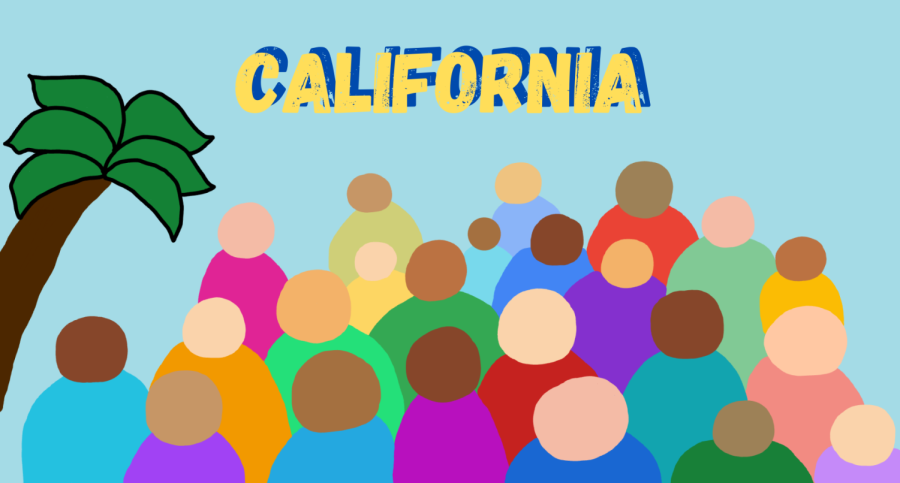California’s Big and Diverse Population
October 24, 2022
The great state of California has a huge, diverse population of roughly 40 million people. We produce a huge quantity of agriculture, the biggest GDP out of all the states, and we’re the third largest state by size. California is home to the biggest Latin-American and Asian-American population in the country, but how did we get to where we are today? Our state’s history has a lot to do with this.
Originally populated by around 130,000 Indigenous Californians, the territory was soon conquered and settled by the Spanish, Russian, and English Empires. However, the Spanish would take the most interest in this newly discovered land, sending many expeditions to build missions, forts, and cities. The huge campaign by the Spaniards to Christianize the Indigenous would take place due to the number of missionaries. Forced labor was also pushed upon them.
After The Mexican War of Independence in 1821, ‘Alta California’ would now be under Mexican administration. More land grants were given to White settlers and Mexicans with connections to the government. With European and American settlers going to Oregon, they would slowly encroach on northern California. In the late 1830s and early 1840s, the territory’s White population grew. These White settlers were soon coming in the thousands, and the Mexican government stopped giving land grants. This would anger the Americans in California, who would revolt and proclaim the formation of The California Republic.
Our state was independent for about a month, before joining the United States following the end of the Mexican-American War. The U.S was victorious and annexed California, Texas, New Mexico, Arizona, Colorado, and Utah. Right after, The Gold Rush occurred after gold nuggets were discovered by James Wilson Marshall.
About 4,000 people migrated to California by August 1848 after hearing about the discovery of gold. This valuable material attracted around 40,000 people by boat into San Francisco, and another 40,000 came by wagon from the eastern United States. This influx of immigrants helped the state obtain its statehood in 1850, which was a part of the Compromise of 1850. Then the Southern States seceded, prompting the Civil War, and California stuck with the Union. No battles would take place in the state, however.
A large number of Chinese immigrants were brought in for the construction of the transcontinental railroad. These immigrants would work for much cheaper wages than the White workers, which caused a wave of anti-Chinese sentiment amongst Californians. As a result, the Chinese Exclusion Act of 1882 would ban Chinese immigrants from coming to America for 10 years. Another mass migration amongst African-Americans would also occur during this time, after the end of slavery and the rise of Jim Crow laws after federal soldiers left the South.
In the late 19th and early 20th century, a massive wave of European immigrants came to the United States through New York. Some came to California, further helping its growth in population. Then between 1910-1920, Mexico was in a bloody revolution that displaced many people who flocked to bordering states, including California.
The creation of Hollywood in the 1920s would greatly grow the Californian economy and attract business and people. The following Great Depression also brought many Americans looking for work to the Golden State. The biggest growth in population would happen before and after World War II, starting with a huge migration of academics, such as Albert Einstein and Robert Oppenheimer, to the West Coast.
In the ’70s and ‘80s, huge growth in both big and smaller communities in California happened. The vast majority of corporate headquarters were now in Southern California, after being previously based in San Francisco for around a century. Another big population growth that started around this time was due to an increase in illegal immigration across the southern border.
Arcadia’s population in 1970 was 42,868 and barely grew to 48,280 by 1990. A big reason for this is due to Arcadia being generally a very expensive place to live. Most immigrants that come don’t have a lot of money, and on top of that Arcadia doesn’t have that much industry. So during this time, Arcadia didn’t experience the general growth that was happening around Southern California.
“I would say that opportunity is the main reason why people come to California,” said Arcadia High School Modern World History teacher Mr. Freese. “Ever since its push to enter the union back in the mid-1800s people came over here to find gold, and while some did others were not so lucky. But these people found much more than gold, they found other resources, natural beauty, and weather. People from abroad heard about such an opportunity, which brought even more people. With the construction of the aqueducts that distribute water throughout the state, farming became a huge part of the California economy, which attracted a lot of migrant workers to come from Mexico and other parts of the world for the opportunity to work.”
As we can see many things attracted people to California such as work, politics, and opportunity. Opportunity is the biggest thing that brings people to our state, which is why we have approximately 40 million people!

